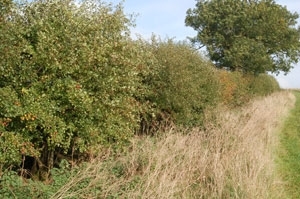Dear Sir,
 That hedges are good for wildlife & the character of our countryside is already well recognised (Farmers urge UK government to fund hedge creation to bolster biodiversity). However, few appreciate that their linear, three-dimensional structure also means they can capture carbon at twice the rate of woodland. And it’s not just about planting new hedges. There are some 402,000km of managed hedgerows in Britain, with an additional 145,000km of relict hedgerows in need of management. It’s estimated that together they store some 9 million tonnes of carbon valued at £65m at base carbon prices. There is enormous potential for this figure to be increased by filling up holes, restoring relict hedgerows and allowing hedgerows to grow outwards and upwards.
That hedges are good for wildlife & the character of our countryside is already well recognised (Farmers urge UK government to fund hedge creation to bolster biodiversity). However, few appreciate that their linear, three-dimensional structure also means they can capture carbon at twice the rate of woodland. And it’s not just about planting new hedges. There are some 402,000km of managed hedgerows in Britain, with an additional 145,000km of relict hedgerows in need of management. It’s estimated that together they store some 9 million tonnes of carbon valued at £65m at base carbon prices. There is enormous potential for this figure to be increased by filling up holes, restoring relict hedgerows and allowing hedgerows to grow outwards and upwards.
The carbon captured by both restoration and planting hedges can be accounted for through the Hedgerow Carbon Code, developed by the GWCT’s Allerton Project, which will soon be commercially available for use on-farm. This new code could help to add to existing and future public funding, making the economics of hedge establishment and maintenance more attractive and rapidly escalate the rate of new planting.
Yours sincerely,
Dr Alastair Leake
Director of Policy and The Allerton Project, Game & Wildlife Conservation Trust